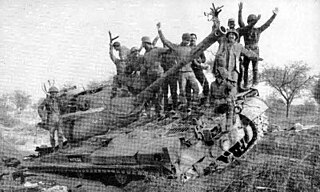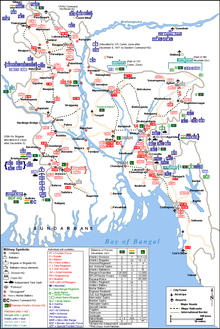
The 4th Indian Infantry Division, also known as the Red Eagle Division, is an infantry division of the Indian Army. This division of the British Indian Army was formed in Egypt in 1939 during the Second World War. During the Second World War, it took part in campaigns in East Africa, Syria, North Africa and Italy. Post independence, the division is part of the I Corps and headquartered at Prayagraj.
39th Indian Infantry Division was an infantry division of the Indian Army during World War II, which became a training division in 1943 after its recovery into India from Burma. The division was re-raised after independence and 39 Mountain Division is presently located in Palampur, Himachal Pradesh under XVI Corps.
The 1st Armoured Division is an armoured division of the Indian Army, headquartered at Patiala, Punjab. It is part of II Corps of the Indian Army's Western Command.

The Parachute Regiment is an airborne and special forces regiment of the Indian Army. It was raised in 1945 as part of the British Indian Army but was disbanded after World War II and was re-raised in 1952 as part of the Indian Army. Currently it consists of fifteen Special Forces, two Territorial Army and one Rashtriya Rifles battalions.

The Battle of Basantar, also known as the Battle of Shakargarh or Battle of Barapind, was one of the vital battles fought as part of the Indo-Pakistani War of 1971 in the western sector of India. The Indian troops won a hard-fought battle that secured this area in the Punjab/Jammu sector. The name Battle of Basantar actually encompasses the entire gamut of battles and skirmishes fought in the Shakargarh sector.

Para (Special Forces), also known as Para Commandos or Para (SF) Commandos, is a group of special forces battalions of the Parachute Regiment in the Indian Army. These units specialize in various roles including counter-terrorism, hostage rescue, unconventional warfare, special reconnaissance, counter-insurgency and direct action.

The Tangail Airdrop was an airborne operation conducted by the Indian Army in order to seize Poongli Bridge and ferry in the Tangail area. The operation, involving 2 Para of the Indian Army's Parachute Regiment is often regarded as one of the largest - if not the largest - airborne operation following World War 2. The operation saw the capture of all objectives and the repulsion of the Pakistan Army's 93rd Infantry Brigade which was attempting to withdraw to Dhaka to bolster its defence.

The 10th Indian Infantry Division was a war formed infantry division of the Indian Army during World War II. In four years, the division travelled over 4,000 miles (6,400 km) from Tehran to Trieste, fought three small wars, and fought two great campaigns: the Anglo-Iraqi War, the Invasion of Syria–Lebanon, the Anglo-Soviet invasion of Iran, the North African Campaign, and the Italian Campaign.
Operation Cactus Lilly, better known as The Meghna Heli Bridge or the Crossing of the Meghna, was an air assault operation conducted between 9 and 12 December 1971 during the Indo-Pakistani War of 1971. It was conducted by the Indian Army and Indian Air Force to cross the Meghna River, bypass a Pakistani stronghold at Ashuganj/Bhairab Bazar and reach Dhaka. The operation is generally regarded as the brainchild of Maj. Gen. Sagat Singh. Without it, Indian forces would not have been able to complete the encirclement of Dhaka and it would likely have led to a lengthening of the war.

Lieutenant General Sagat Singh, PVSM was a General Officer in the Indian Army, notable for his participation in liberation of Goa and later in Indo-Pakistani war of 1971. He held many commands and staff appointments throughout his career.
The 11th Indian Infantry Division was an infantry division of the Indian Army during World War II. It formed part of Indian III Corps in the Malaya Command during the Battle of Malaya. The division was re-raised on 1 April 1965 and is presently part of the XII Corps of Southern Command. It is presently responsible for safeguarding the borders with Pakistan along Southern Rajasthan and Gujarat.
The 15th Indian Division was an infantry division of the British Indian Army that saw active service in the First World War. It served in the Mesopotamian Campaign on the Euphrates Front throughout its existence. It did not serve in the Second World War, but was reformed at Dehradun in 1964 as part of the post-independence Indian Army.

The Regiment of Artillery is a combat/fighting arm of the Indian Army, which provides massive firepower during all ground operations of the Indian Army. It is a successor to the Royal Indian Artillery (RIA) of British Indian Army, which itself traces its origins to the formation of Bombay Artillery in 1827.
The Indian Army had no standby force ready in 1971 with the specific task of attacking East Pakistan, one of the many reasons why India did not immediately intervene after Pakistan launched Operation Searchlight in March 1971. Indian Army's Eastern Command was tasked with defending the northern and eastern borders and fighting the insurgencies in Nagaland, Mizoram and Naxalites in West Bengal at that time.

The 50th Parachute Brigade is a brigade-sized formation of the Indian Army. Its main force is formed of battalions of the Parachute Regiment. It consists of 3 Parachute Regiment battalions, supported by units of the Regiment of Artillery, the Corps of Engineers and the Army Medical Corps

The 54th Infantry Division is an Infantry division of the Indian Army. The Division was raised as an Infantry Division, but was converted into a Reorganised Amphibious Formation (RAMFOR) in 2011. It is currently the only division of the Indian Army which carries out Amphibious warfare. The division is headquartered at Secunderabad in Telangana and is a part of XXI Corps. The Division is commanded by an Officer of the rank of Major General titled General Officer Commanding (GOC).
169 Medium Regiment (OP Hill) is part of the Regiment of Artillery of the Indian Army.
32 Field Regiment is part of the Regiment of Artillery of the Indian Army.
1 Field Regiment (Meiktila) is part of the Regiment of Artillery of the Indian Army. It is the first field artillery unit with Indian officers.










